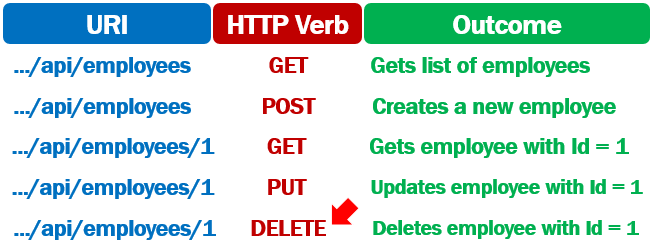Delete in ASP.NET Core REST API
In this video we will discuss, how to delete a resource, i.e implement HTTP DELETE in ASP.NET Core REST API.
To delete a resource, issue an HTTP DELETE request to the URI /api/employees/ID. The ID of the employee to delete must be passed in the URI.

ASP.NET Core REST API - HTTP DELETE Example
[Route("api/[controller]")]
[ApiController]
public class EmployeesController : ControllerBase
{
private readonly IEmployeeRepository employeeRepository;
public EmployeesController(IEmployeeRepository employeeRepository)
{
this.employeeRepository = employeeRepository;
}
[HttpDelete("{id:int}")]
public async Task<ActionResult<Employee>> DeleteEmployee(int id)
{
try
{
var employeeToDelete = await employeeRepository.GetEmployee(id);
if (employeeToDelete == null)
{
return NotFound($"Employee with Id = {id} not found");
}
return await employeeRepository.DeleteEmployee(id);
}
catch (Exception)
{
return StatusCode(StatusCodes.Status500InternalServerError,
"Error deleting data");
}
}
}Code Explanation
It is the DELETE request that is used to delete an existing employee. This is the reason DeleteEmployee() method is decorated with the HttpDelete attribute.
The id of the employee to delete is passed as a parameter to the HttpDelete attribute. This id will be appended to the URL /api/employees. So the URL becomes /api/employees/id
[HttpDelete("{id:int}")]
public async Task<ActionResult<Employee>> DeleteEmployee(int id)The employee id value in the URL is automatically mapped to the id parameter on the DeleteEmployee(int id) method.
As we are using the int route constraint on the id route parameter, the id value in the URL is mapped to the method parameter, only if the value is an integer.
ASP.NET Core Web API CRUD Operations Example
The following is the complete EmployeesController code. We have all the CRUD operations (i.e Create, Read, Update and Delete) implemented.
using EmployeeManagement.Api.Models;
using EmployeeManagement.Models;
using Microsoft.AspNetCore.Http;
using Microsoft.AspNetCore.Mvc;
using System;
using System.Threading.Tasks;
namespace EmployeeManagement.Api.Controllers
{
[Route("api/[controller]")]
[ApiController]
public class EmployeesController : ControllerBase
{
private readonly IEmployeeRepository employeeRepository;
public EmployeesController(IEmployeeRepository employeeRepository)
{
this.employeeRepository = employeeRepository;
}
[HttpGet]
public async Task<ActionResult> GetEmployees()
{
try
{
return Ok(await employeeRepository.GetEmployees());
}
catch (Exception)
{
return StatusCode(StatusCodes.Status500InternalServerError,
"Error retrieving data from the database");
}
}
[HttpGet("{id:int}")]
public async Task<ActionResult<Employee>> GetEmployee(int id)
{
try
{
var result = await employeeRepository.GetEmployee(id);
if (result == null)
{
return NotFound();
}
return result;
}
catch (Exception)
{
return StatusCode(StatusCodes.Status500InternalServerError,
"Error retrieving data from the database");
}
}
[HttpPost]
public async Task<ActionResult<Employee>> CreateEmployee(Employee employee)
{
try
{
if(employee == null)
{
return BadRequest();
}
var emp = employeeRepository.GetEmployeeByEmail(employee.Email);
if(emp != null)
{
ModelState.AddModelError("email", "Employee email already in use");
return BadRequest(ModelState);
}
var createdEmployee = await employeeRepository.AddEmployee(employee);
return CreatedAtAction(nameof(GetEmployee), new { id = createdEmployee.EmployeeId },
createdEmployee);
}
catch (Exception)
{
return StatusCode(StatusCodes.Status500InternalServerError,
"Error retrieving data from the database");
}
}
[HttpPut("{id:int}")]
public async Task<ActionResult<Employee>> UpdateEmployee(int id, Employee employee)
{
try
{
if(id != employee.EmployeeId)
{
return BadRequest("Employee ID mismatch");
}
var employeeToUpdate = await employeeRepository.GetEmployee(id);
if(employeeToUpdate == null)
{
return NotFound($"Employee with Id = {id} not found");
}
return await employeeRepository.UpdateEmployee(employee);
}
catch (Exception)
{
return StatusCode(StatusCodes.Status500InternalServerError,
"Error updating data");
}
}
[HttpDelete("{id:int}")]
public async Task<ActionResult<Employee>> DeleteEmployee(int id)
{
try
{
var employeeToDelete = await employeeRepository.GetEmployee(id);
if (employeeToDelete == null)
{
return NotFound($"Employee with Id = {id} not found");
}
return await employeeRepository.DeleteEmployee(id);
}
catch (Exception)
{
return StatusCode(StatusCodes.Status500InternalServerError,
"Error deleting data");
}
}
}
}EmployeeRepository
EmployeeRepository uses entity framework core to store and retrieve data from SQL Server database.
public class EmployeeRepository : IEmployeeRepository
{
private readonly AppDbContext appDbContext;
public EmployeeRepository(AppDbContext appDbContext)
{
this.appDbContext = appDbContext;
}
public async Task<Employee> AddEmployee(Employee employee)
{
var result = await appDbContext.Employees.AddAsync(employee);
await appDbContext.SaveChangesAsync();
return result.Entity;
}
public async Task<Employee> DeleteEmployee(int employeeId)
{
var result = await appDbContext.Employees
.FirstOrDefaultAsync(e => e.EmployeeId == employeeId);
if (result != null)
{
appDbContext.Employees.Remove(result);
await appDbContext.SaveChangesAsync();
return result;
}
return null;
}
public async Task<Employee> GetEmployee(int employeeId)
{
return await appDbContext.Employees
.FirstOrDefaultAsync(e => e.EmployeeId == employeeId);
}
public async Task<Employee> GetEmployeeByEmail(string email)
{
return await appDbContext.Employees
.FirstOrDefaultAsync(e => e.Email == email);
}
public async Task<IEnumerable<Employee>> GetEmployees()
{
return await appDbContext.Employees.ToListAsync();
}
public async Task<Employee> UpdateEmployee(Employee employee)
{
var result = await appDbContext.Employees
.FirstOrDefaultAsync(e => e.EmployeeId == employee.EmployeeId);
if (result != null)
{
result.FirstName = employee.FirstName;
result.LastName = employee.LastName;
result.Email = employee.Email;
result.DateOfBrith = employee.DateOfBrith;
result.Gender = employee.Gender;
result.DepartmentId = employee.DepartmentId;
result.PhotoPath = employee.PhotoPath;
await appDbContext.SaveChangesAsync();
return result;
}
return null;
}
}© 2020 Pragimtech. All Rights Reserved.

